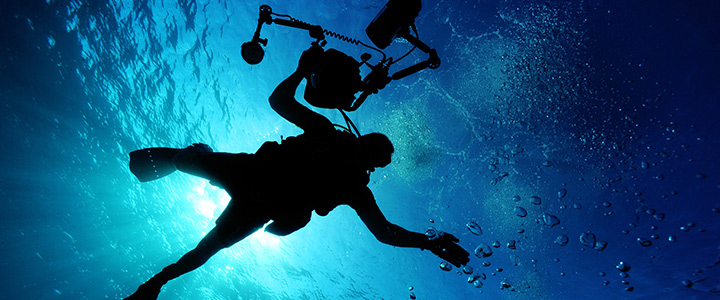Underwater networks
Our oceans and seas remain largely unexplored due to the hostile nature of the environment, yet they contain a wealth of resources, pristine nature and biodiversity. Improvement in wireless communications would transform our ability to explore the oceans, by enabling unobtrusive real time continuous data collection and control of underwater devices from remote sites. Such technology would allow us to gather a wealth of data to better understand the Earth’s natural processes, monitor marine life, and protect biodiversity. It will help predict natural disasters and undoubtedly lead to the discovery of new ecosystems, sources of energy, food and medicine.
Current underwater deployments often comprise low numbers of instruments recording data during a mission for later retrieval. This is an inflexible approach which inhibits adaptation or control of sensing tasks. Acoustic signals are most suitable for long-distance transmission, but the oceans present a different scale of challenge for signal propagation. The focus of our research is to exploit knowledge of underwater acoustic propagation and develop advanced point to point communication and networking capability. Topics of current interest include:
Download our Waymark Based Underwater Acoustic Channel Model
- Modelling of underwater acoustic communication channels (at the signal level)
- Physical layer signalling for underwater acoustic communication
- Full duplex underwater acoustic communications
- Intelligent medium access control protocols for underwater acoustic networks
- Localisation of nodes in underwater communication networks
- Exploitation of relays for enhanced communication performance
- Multi-hop underwater networks
We are currently working on an EPSRC funded research project USMART (smart dust for large scale underwater wireless sensing - EP/P017975/1) which runs from April 2017 until March 2020, specifically looking at channel modelling and the development of advanced medium access control and routing techniques.
Projects
- Smart Dust for Large Scale Underwater Wireless Sensing
- Medium Access Control Protocols for Underwater Acoustic Networks
- Advanced Signal Processing Techniques for Underwater Acoustic Imaging
- Self-Interference Cancellation for Full-Duplex Underwater Acoustic Systems
- Intelligent Medium Access Control for Underwater Acoustic Communication Networks
- Full-duplex MAC protocol for Underwater Acoustic Networks
- Multi-Antenna Underwater Acoustic Communication Systems
- Effective Medium Access Control for Underwater Acoustic Sensor Networks
- Intelligent Medium Access Control for Underwater Acoustics Communication Networks
- Development of real-time UWA communication modem
Contact
Dr Paul Mitchell
paul.mitchell@york.ac.uk
Tel: +44 (0)1904 32 2415
Partners
Previous or current non-academic collaborators include:
- Proserv (Nautronix)
- Subsea 7 Limited
- TECHNIP-COFLEXIP UK HOLDINGS LIMITED


